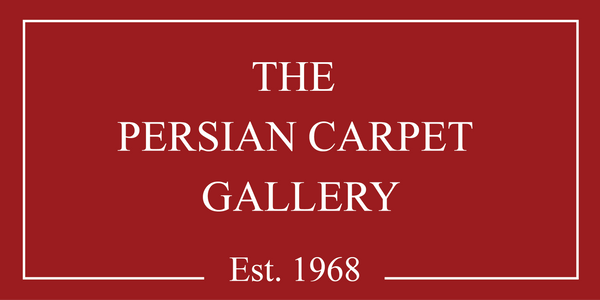Blogs
Scenes from Persian Romances in the Musée des Arts Décoratifs, Paris.
This exquisite 16th-century Persian carpet, housed in the Musée des Arts Décoratifs, Paris, is a masterpiece of storytelling and craftsmanship. Titled ‘Scenes from Persian Romances’ by art historian Arthur Upham Pope, it is believed to originate from Kerman, though its intricate design suggests the work of a master miniaturist.
The carpet’s rich imagery features hunters on horseback, a reclining man with seated women, and a central elephant, all set against a floral background. Among the fauna, a pair of phoenixes (simurghs) symbolize rebirth, while the border showcases medallions with seated figures and winged beings, adding to its mythical and romantic theme.
This remarkable piece is a woven narrative of Persian culture, poetry, and artistic brilliance, reflecting the golden age of Safavid textile art.
The Silk Medallion & Arabesque Carpet: at the Musée des Gobelins, Paris
The Silk Medallion and Arabesque Carpet is a 16th-century Persian masterpiece from Kashan, currently housed in the Musée des Gobelins, Paris. Woven entirely from luxurious yellow silk, it boasts an exceptional knot density of 998,400 knots per square meter, showcasing the extraordinary craftsmanship of the Safavid era. The design features a central medallion with intricate arabesques and floral motifs, surrounded by a rich red field adorned with stylized clouds and flowers. Its three-band border, with varying widths, highlights delicate arabesques interwoven into a floral seed pattern.
This rug is part of an elite group of 16th-century silk carpets, considered among the finest ever created. A similar piece resides in the Metropolitan Museum of Art, reinforcing its historical and artistic significance. Persian silk carpets from Kashan were often crafted for royal courts, prized for their exquisite detail and luminous silk textures. Today, they remain highly sought-after as both artistic treasures and cultural heirlooms, embodying the grandeur of Persian textile heritage.
A Masterpiece carpet in the Metropolitan Museum of Art, New York
This stunning Persian carpet from Kashan, crafted in the late 16th century, showcases exquisite artistry and craftsmanship. Measuring 258 x 179 cm, it features a silk warp, weft, and pile with an impressive knot density of 921,600 knots per square meter.
The design elegantly combines motifs of animals and flowering shrubs, distinguished by its meticulous execution. Its intricate borders include floral patterns, cloud bands, and large palmettes surrounded by birds, possibly pheasants.
Previously part of Benjamin Altman’s collection, this rare masterpiece stands as a remarkable testament to Persian textile artistry, now preserved in one of the world’s most prestigious museums.
All-Over Animal and Floral Carpet at the Österreichisches Museum für angewandte Kunst, Vienna
This magnificent Persian carpet, crafted in Central Persia during the mid-16th century, is a highlight of the Österreichisches Museum für angewandte Kunst (MAK) in Vienna. Measuring 760 x 325 cm, it features an impressive knot density of 495,000 knots per square meter, woven with silk warp, silk weft, and wool pile.
The design is divided into four identical sections filled with elegant arabesques, cloud bands, and lush floral patterns. Among the intricate foliage, fierce confrontations between animals—lions, tigers, antelopes, and more—are vividly depicted, symbolizing nature’s beauty and chaos.
This carpet stands as a remarkable example of Persian craftsmanship, reflecting the artistic sophistication of the Safavid era and continuing to captivate art enthusiasts around the world.
Iran National Art Museum Silk Rug
This exquisite Rug, crafted in Tabriz during the early 16th century, is a hallmark of Persian artistry and sophistication. Preserved at the Iran Bastan Museum in Tehran, it measures 204 x 195 cm and features an extraordinary density of 693,000 Turkish knots per square meter.
Made with a white silk warp and weft, its silk pile is enriched with luxurious gold and silver threads. The design showcases a central medallion surrounded by intricate cloud-bands inspired by Chinese motifs, along with depictions of animals, birds, and possibly fish. The delicate border, adorned with gold and silver accents, frames the piece beautifully, enhancing its visual appeal.
A symbol of the Safavid era's artistic excellence, this carpet reflects the unmatched skill and creativity of Persian weavers, offering a glimpse into a golden age of textile craftsmanship.
The Silk Medallion Carpet
The Silk Medallion Carpet, crafted in Northwest Persia in the first half of the 16th century, exemplifies the artistry of Persian weavers, likely originating from Tabriz. Measuring 250 x 170 cm, it is made from silk and metallic thread, utilizing the Turkish knot technique.
The design features a blend of floral patterns and symbolic motifs, with medallions adorned by four peacocks framed within cartouches and crowned by distinctive "tchi" motifs. The border complements the field with cloud-band motifs encircling decorative cartouches, seamlessly integrating arabesques and floral patterns.
Housed in the Musée des Arts Décoratifs in Paris, this masterpiece highlights the cultural and artistic excellence of 16th-century Persia.
The Chelsea Rug
This 16th-century Persian rug, housed in the Victoria and Albert Museum in London, is a masterpiece of artistry and craftsmanship. Known as the "Chelsea Carpet," it features 738,700 Persian knots per square meter and a luxurious combination of silk and wool. Its intricate design includes medallions, blossoming trees, mythical creatures like phoenixes and dragons, and a serene central pool filled with fish. Sharing a stylistic connection with the famed Ardabil Carpet, it is considered one of the most beautiful rugs in the world, showcasing Persia's rich cultural legacy in carpet weaving.
The Persian Carpet: Up to 1800
Materials Used in Persian Carpets
The extraordinary quality of Persian carpets begins with the fine, supple fleece of Persian sheep, famously known as "oily sheep" due to their fatty skin. This unique wool, prized for its exceptional strength and durability, is primarily used for the pile of the carpet and occasionally for the warp and weft. The pile is typically crafted from two single threads twisted together to create a strong two-strand structure, ensuring longevity and resilience.










